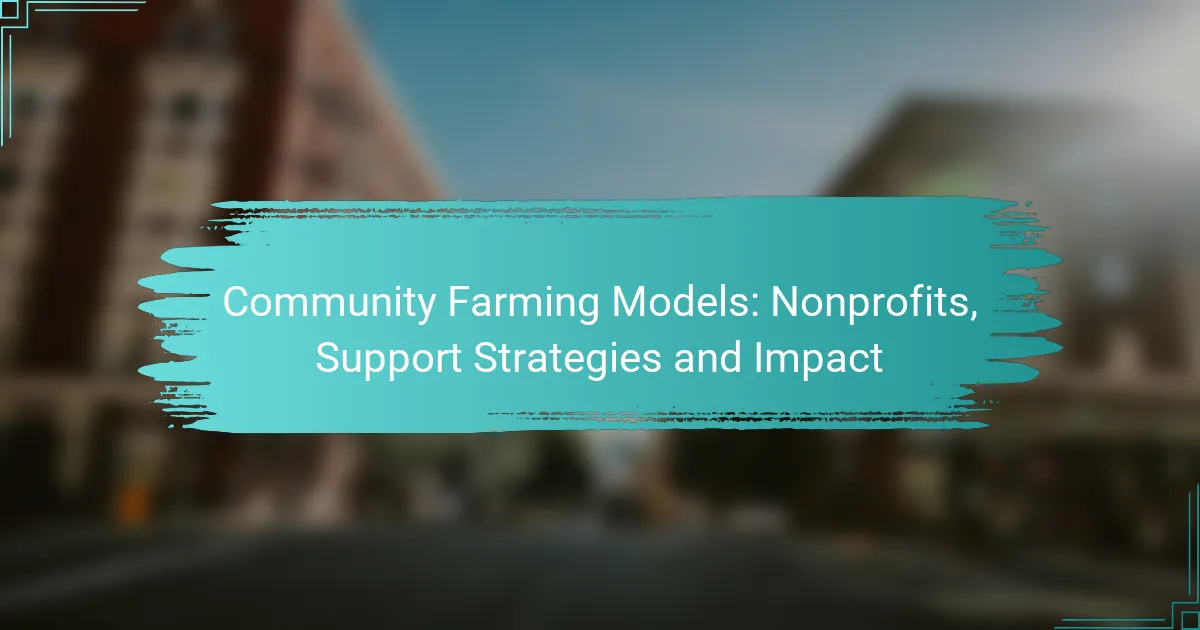Community farming models in the United States are diverse approaches that enhance local food production and foster community engagement. Nonprofits play a vital role in these initiatives by providing resources and expertise, which help establish sustainable practices and improve food security. Through various strategies, community farming not only enhances food access but also strengthens social ties and boosts local economies.

What are the community farming models in the United States?
Community farming models in the United States encompass various approaches that promote local food production, sustainability, and community engagement. These models include nonprofit farms, cooperatives, urban agriculture, school programs, and community-supported agriculture (CSA), each serving unique roles in enhancing food security and fostering community ties.
Nonprofit community farms
Nonprofit community farms operate with the primary goal of serving the community rather than generating profit. They often focus on education, food access, and environmental sustainability, providing fresh produce to local residents, especially in underserved areas.
These farms may rely on grants, donations, and volunteer labor to sustain operations. For example, a nonprofit farm might offer sliding scale pricing for low-income families, ensuring that fresh food is accessible to all community members.
Cooperative farming initiatives
Cooperative farming initiatives involve groups of individuals who collaboratively manage a farm, sharing resources, responsibilities, and profits. This model promotes equitable access to land and agricultural knowledge, allowing members to benefit from collective efforts.
Members typically contribute labor and capital, and profits are distributed based on participation. An example is a cooperative that grows organic vegetables, where members receive a share of the harvest proportional to their investment and labor contributions.
Urban agriculture projects
Urban agriculture projects focus on cultivating food within city environments, utilizing vacant lots, rooftops, and community gardens. These initiatives aim to increase local food production, reduce food deserts, and enhance community engagement.
Urban farms often incorporate innovative techniques such as vertical farming and hydroponics. A city might support these projects through zoning changes or grants, allowing residents to grow food in previously unused spaces.
School-based farming programs
School-based farming programs integrate agriculture into educational curricula, teaching students about food production, nutrition, and environmental stewardship. These programs often involve hands-on learning experiences in school gardens or farms.
Such initiatives can improve students’ understanding of healthy eating and sustainability. Schools may partner with local farms to provide fresh produce for their cafeterias, creating a direct connection between students and local agriculture.
Community-supported agriculture (CSA)
Community-supported agriculture (CSA) is a model where consumers purchase shares of a farm’s harvest in advance, providing farmers with upfront capital and ensuring a market for their produce. This model fosters a direct relationship between consumers and producers.
Typically, CSA members receive regular deliveries of seasonal produce, which can vary based on the farm’s yield. This approach encourages community involvement and can help mitigate the risks associated with farming, as members share in both the bounty and the challenges of the growing season.

How do nonprofits support community farming?
Nonprofits play a crucial role in supporting community farming by providing essential resources, funding, and expertise. They help establish sustainable agricultural practices, enhance community engagement, and promote food security through various strategies.
Funding and grants
Nonprofits often secure funding and grants to support community farming initiatives. These funds can come from government programs, private foundations, or crowdfunding efforts. Grants typically cover costs such as land acquisition, equipment purchases, and operational expenses.
Organizations should research available grants specific to agriculture and community development. For example, the USDA offers various grant programs that can be beneficial for community farms in the United States.
Volunteer programs
Volunteer programs are essential for community farming, as they provide manpower and foster community involvement. Nonprofits often organize volunteer days where community members can help with planting, harvesting, and maintenance tasks.
Engaging volunteers not only reduces labor costs but also builds a sense of ownership and connection to the farm. Nonprofits should consider creating structured volunteer programs that include training sessions and recognition events to maintain enthusiasm.
Educational workshops
Educational workshops are a key strategy for nonprofits to empower community members with farming knowledge. These workshops can cover topics such as sustainable farming techniques, pest management, and nutrition education.
Hosting workshops can attract diverse participants and foster collaboration among local farmers. Nonprofits should aim to offer workshops regularly and tailor them to the specific needs of the community, ensuring relevance and engagement.
Partnerships with local businesses
Forming partnerships with local businesses can significantly enhance the sustainability of community farming initiatives. Nonprofits can collaborate with local restaurants, grocery stores, and farmers’ markets to create a network that supports local food systems.
These partnerships can lead to mutually beneficial arrangements, such as sourcing fresh produce directly from community farms. Nonprofits should actively seek out local businesses interested in promoting sustainable practices and supporting community agriculture.

What are the impacts of community farming on local communities?
Community farming significantly enhances local communities by improving food access, fostering social ties, promoting environmental health, and boosting local economies. These initiatives create a sustainable model that benefits both individuals and the broader community.
Food security improvement
Community farming directly addresses food security by providing fresh, locally grown produce to residents. This access reduces reliance on imported goods and can lower food costs, making nutritious options more available to low-income families.
Many community farms operate on a model where participants can receive a share of the harvest, ensuring a steady supply of food throughout the growing season. This approach not only enhances food availability but also encourages healthy eating habits.
Community engagement and cohesion
Community farming fosters engagement by bringing people together to work towards a common goal. Participants often form strong bonds through shared labor, leading to increased social interaction and a sense of belonging.
These farms can serve as gathering places for workshops, events, and educational programs, further strengthening community ties. By involving diverse groups, community farming promotes inclusivity and collaboration among residents.
Environmental sustainability
Community farming practices often prioritize sustainable methods, such as organic farming and permaculture, which help preserve local ecosystems. These practices can improve soil health, reduce water usage, and promote biodiversity.
By focusing on local food production, community farms can also decrease carbon footprints associated with transportation and packaging of food. This environmental consciousness contributes to a healthier planet and community.
Economic benefits for local farmers
Community farming provides economic advantages for local farmers by creating direct sales channels to consumers. This model allows farmers to retain a larger share of the profits compared to traditional retail methods.
Additionally, community farms can stimulate local economies by creating jobs and supporting related businesses, such as local markets and suppliers. Investing in community farming can lead to a more resilient local economy overall.

What criteria should be considered when choosing a community farming model?
When selecting a community farming model, it is essential to consider the specific needs of the community, the resources available, and the geographic context. These criteria help ensure that the farming initiative is sustainable, impactful, and tailored to local conditions.
Community needs assessment
A thorough community needs assessment identifies the priorities and preferences of local residents regarding food production and agricultural practices. Engaging with community members through surveys, focus groups, or public meetings can reveal insights into desired crops, farming methods, and educational opportunities.
Understanding community demographics, such as income levels and food access issues, can guide the selection of a farming model that addresses these challenges. For instance, if a community struggles with food insecurity, a model focusing on high-yield crops or educational programs about nutrition may be beneficial.
Available resources and funding
Evaluating available resources and funding is crucial for the viability of a community farming model. This includes assessing land access, equipment, and human capital, such as volunteers or skilled workers. Identifying potential funding sources, such as grants, donations, or partnerships with local businesses, can also support the initiative.
Community farms can explore various funding avenues, including local government programs, nonprofit grants, or crowdfunding campaigns. It’s important to create a budget that outlines expected costs and potential revenue streams to ensure financial sustainability.
Geographic location
The geographic location of a community farming initiative significantly influences its design and operations. Factors such as climate, soil quality, and proximity to markets affect what crops can be grown and how easily produce can be sold. For example, urban farms may focus on high-value crops that can be sold directly to consumers, while rural farms might have more land available for diverse agricultural practices.
Additionally, local regulations regarding land use, zoning, and agricultural practices must be considered. Understanding these regulations can help avoid legal issues and ensure compliance, which is essential for the long-term success of the farming model.
